Power, Sound, R/C
:
Power Supplies
Growing Railroads need Growing Power
Dec 22, 2004


By John B Pedersen |
Author
Bio
The power for my "Empire" was a Lionel Trainmaster 1034 75 Watt transformer. I still have that fully functional transformer, and occasionally use it for lighting at Christmas time.
|
I have "played" with, built and generally enjoyed trains my entire life. It started with a Lionel O-27 set on a 4' X 8' board my father made to be used at Christmas time. I used to run those trains for hours and hours each year till it was time to put it away till the next year. I had several small engines so I could only run one at a time, so a large transformer was not needed. The power for my "Empire" was a Lionel Trainmaster 1034 75 Watt transformer. I still have that fully functional transformer, and occasionally use it for lighting at Christmas time. 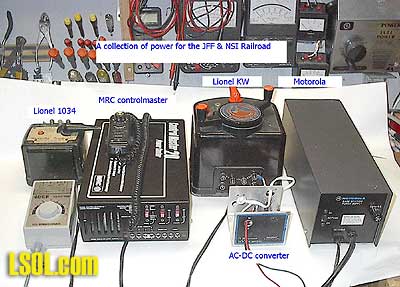
When I got older I started a larger layout in the basement of my home and graduated to a Lionel KW 190 watt transformer, which is still fully functional and was used for a long time. More on that later. After I got married we lived in apartments so any kind of layout was impossible. I would dig up my Lionel O-27 trains for around the Christmas tree, and around as much of the room as I could get away with. I started a small HO point to point layout on a wall powered with a small supply that came with a small train set. It worked well for what I was doing. Mostly I spent time building parts and pieces for the railroad which I like to do. Soon the family grew, the amount of space got less and less, and then we moved 800 miles so I had to abandon any form of layout for many years. After getting a house to rent I built an "N" layout on a 3'X 4' base, and it expanded to 3' X 7' with in a couple of years. I made a control panel and built 2 power supplies into the panel for dual control. The layout had about 8 individual blocks so 2 people could run at the same time. These supplies were 12 Volt @ 2 amps each, so power was never a problem. Unfortunately time (age) started to show, as those trains got smaller and smaller. They were hard to see, and my fingers felt like they were getting fatter, so handling small parts was difficult. Bye Bye "N" gauge.
I went back to my Lionel setup at Christmas time, but that just wasn't the same nor was it enough train running time. One day a few years back my wife and I went to a shopping mall in October or November. When we walked in the door my mouth fell open and I stopped short in the doorway. In front of us was an entire mall full of TRAINS running all over the place. Not small (HO -N or O-27) but "Large" trains. I soon found out they were "G" size, and I was hooked totally, I had to have some. By Christmas I had an LGB Stainz set and extra track using the power supply that came with the set. Big trains were running around the tree, life was getting better! Within 2 years we had put a small pre-formed pond in the yard, and the bells went off in my head, it needed a small railroad around it like I had seen in the magazines. Thus begins the saga of more and better. As the rails expanded West (east-south-north etc.) so did the rolling stock and power requirements. This is that story (history) of power on the JFF & NSI Railroad from the early start to today October 2004. The name of the railroad is an acronym for "Just For Fun-No Scale Intended", and I stick to it. Before the outdoor rails, I used the trains around the Christmas tree, living room, front porch and into the dining room, and I still do this each year. This layout stays for 2-to-3 months depending on a variety of factors. The very first transformer was the LGB that came with the first set. It worked well enough with the small LGB, but with a limited capability for some newer rolling stock I purchased. Running an Aristo Rogers with 3 fully lit Sierra passenger cars was just a little too much for it. I saw an ad in a magazine for a larger power supply, a MRC Trainpower 6200 60 VA (watt)= 3.74 amps unit. It had considerably more power than the older unit and could handle the Rogers and 5 Sierra cars with lights and smoke for up to 1 hour before it shut down on internal overload. I stopped using the smoke, and it would not over heat, boy I was in seventh heaven, I could now run several small engines and limited lighting in the cars. It never failed to impress visitors that came to watch the "nut" "play" with his trains that ran all over the house at Christmas time. That Trainpower 6200 did well for a couple of years till a voltage regulator broke down and shot 20+ volts to the rails, and I could not shut it off quick enough to prevent a train wreck second to none in 1:1 scale. I repaired the supply but never trusted it again. 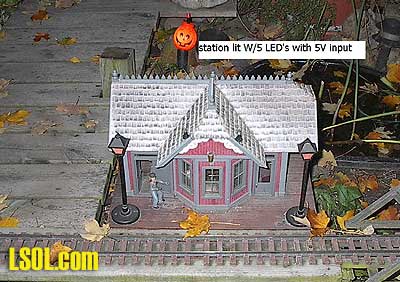
My wife and I went to visit my mother in Florida; it was not a vacation kind of visit, so we had little time to go anywhere. When time was available we made the most of it, and went to some stores we would each like. Some for her and of course for me train shops. While in a very large store near Orlando I spotted an MRC Control Master 20 with walk around control. It boasted 20 Volts and 65 VA (Watts). I really liked the operational options it afforded me. I had it shipped to me at home and was there before me. It seemed to deliver more than its rating. I had no trouble with multiple engines and again the Sierra cars with smoke and lights. It also gave me power for accessories like electric turnouts I was using indoors at Christmas. I moved it to the basement in the spring and connected to the track and accessory wires to the outdoor RR. I ran a #18 thermostat wire to an outside phone jack and connected the other end to the walk around control jack of the Control Master. Now I had 20 feet of coiled cord to use around the railroad. Life was really getting better, or I was getting lazy, I'm not sure which. Now that my power for Christmas was connected to outdoors, I needed some thing for indoors. I had seen an ad for a CMI Blue Hogger #101 with walk around at a good price, so I bought one. This machine was capable of 20 Volts @ 90 VA (watts) =4.5 amps. Now I was set for in and out with power to spare. Suddenly the "Blue" would shut down at low amps for no reason, and got worse and worse. I sent it to CMI, and they sent me its replacement, a Super Blue Hogger #156 with the same ratings as the old with all new walk around controls. It still works well and it is used for the shelf railroad around the living room ceiling and has been in use for several years. 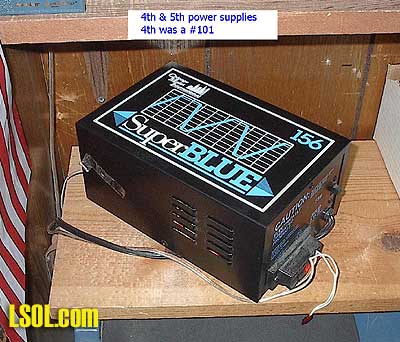
Next upgrade to the system was to get a Crest Train Engineer system, and cut the cord so to speak. Now I had power supplies with controls that did not favor a TE system. Once more the light bulb lit, and I took that KW 190 watt transformer and built a full wave filtered AC/DC converter using a 50 Amp full wave rectifier and 6000 MFD capacitors. When done it only had 2 volts of ripple and 19-20 volts DC to the track @ 95 Watts=4.75 amps. I used 12volts from the other side for accessories. Now the TE worked very well and once more I had power to spare. You may ask why do I want so much power. Well my railroad is elevated and I can run trains 12 months a year. I have several plows that I use to keep the rails clear, some times depending on the snow I run 4 engines to push 4 inches of mother nature's finest snow off the rails. The engines I use have multiple motors and running 4 amps is not abnormal, so I am very power minded. Some times I feel like the Tim Allen of railroads, "More Power". I used that system for 2 years and was happy with the performance. Once while checking the voltage to amps I noticed that the voltage dropped to 15 V at 4 amps during a heavy snow and plowing performance was not up to par. As I did not want to destroy my KW I started using less motive power and started looking for other alternatives to get the power I wanted (needed).
I built a control box outdoors that houses the TE receiver with fan for cooling, voltage regulators for accessories, and terminals for the track power and switches to operate my electric switch machines. The box is connected to the inside power supply with #10 stranded wire for track power and # 12 for accessory power.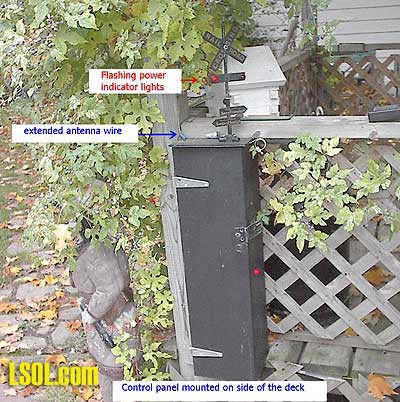
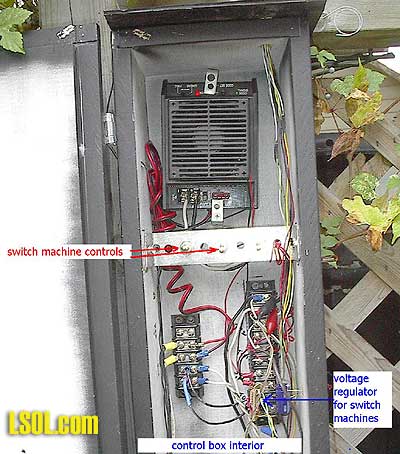
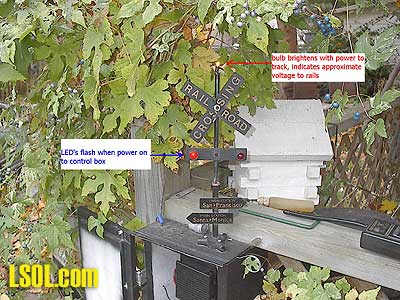
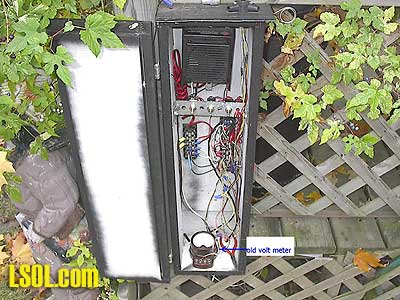
All wiring for any controls and accessories come from here. I was not happy with the range of my TE, so I connected a long wire to the receiver antenna and stung it along the deck railing for 50 feet. Now I can control the trains from 100 feet which is more than enough distance for me.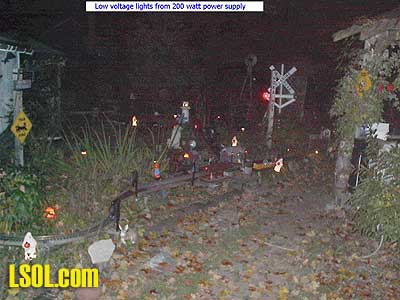
At the start of Christmas last year I was playing with a 200 watt computer power supply from an antique machine. I did some "kit-bashing" of that supply and used the outputs for lighting the indoor village I put up with the trains. I used the 12V outputs for the bunch of buildings I powered with LED's. Look in the archives for an article on LED lighting. I used some 5V for Dept 56 lighting and other accessories. 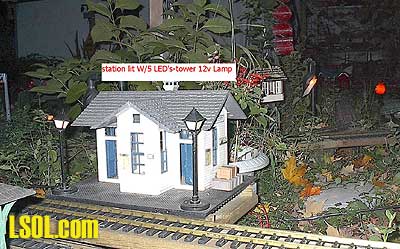
 This worked exceptionally well and cut down the number of supplies I had used from 3 to only one and still had some power to spare. After Christmas and just before putting all the trains and villages away I tried an experiment and connected 12V from the computer power supply to the track and ran 3 engines, lighted cars and all the lights and accessories from that single supply. When I checked the volt to amps ratio, I found that the voltage remained constant at all loads and speeds. The best part is that I was only using about 50% of the power supplies full capability. Another bulb went off and my mind was turning, I needed a 400 Watt-20+Volt supply, now to find one. Because I am using a TE for control I only need a power supply of a single voltage, but I need the amperage for MU running. Electronics is a hobby now, but many years ago I studied it looking toward a career, but life sometimes has other plans for you. I still like to build and tinker with most things electric, so digging into some of these electric projects is second nature to me. As with anything electric common sense precautions should be observed. Don't test for 110 Volts with wet fingers, etc.. Our company discontinued using some of the business FM radio equipment, and discarded most of it. I got my hands on the base station power supply. It had no ratings on it so I measured the volts out at 16V, but did not know the amps for sure. I knew the mobiles pulled in excess of 15 amps when keyed, but did not know about the base station.
I contacted Motorola and talked to a tech rep, he told me that it would handle a minimum of 36 amps, but most likely was a 56 amp supply. 16Volta @36 amps=576 Watts!! 16Volts @56 Amps=896 Watts!! Now that's power and I quickly hooked it up the TE system using #10 stranded wire from its output. That much power could melt rails. The most surprising thing to me was finding out that the unit is protected with a 2 amp fuse, and is designed for continuous operation. Like the computer supply the voltage is constant and the amps increase as needed. For fun I hooked up 6 engines and all the lit cars I had and powered up. I was amazed at its performance. I could open the throttle wide and not worry about any thing leaving the track due to speed. The scale speed showed to be about 60MPH with Aristo Pacific's running at full throttle. 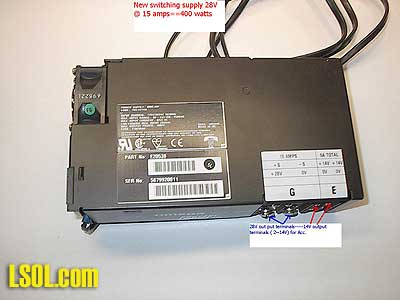
I was still looking for that 400watt, 20+ volt power supplies. I get a bunch of catalogs from electronic suppliers, e-mail catalogs of specials etc. My nephew is a certified computer repairman, and I had him looking also. At the beginning of October I found the unit I was looking for 28Volts @ 15 Amps=400 Watts. The cost with shipping was $47.00. I know that that is 4 volts more than the TE rating but it was worth a try. I hooked it up and it does the job. I do not want to operate over 20-22 volts, even for snow plowing, so I added a relay and warning light that indicates when I reach 20 volts to the rails. I am going to run this for the winter and see how well it works. I can reconnect the big Motorola in 5 minutes time to test its abilities for winter plowing, and I will try it once during the winter.
Why did I write this piece you may ask. Well I read a lot of inquiries on what power supplies people should buy or use for this and that purpose. I am basically a thrifty (cheap) kind of guy who likes a challenge. You can spend anywhere from $50 to half the national debt for a power supply for your railroad empire, and I wanted to show different ways I did mine and the results I got. None of this is "Rocket Science" and nearly all the members of LSOL can handle the work I did to get more and in some cases better power for their railroads. All that is needed is the willingness to try, and I know that is very prevalent amongst the members, and some decent instructions. Several times I have gotten some help from the "Gatorman" Bob Gentile, and from Jon "The Eastern One", just to name a couple. I have gleaned a ton from the Tuesday night chats from all three members involved. I hope this will help someone have an easy time figuring what they want and how to build your own. Using the TE for control gives you the option of pulse width control, standard voltage control and momentum, so a basic single voltage unit will give just about anything you want. The TE will take the filtered DC and convert to PWC for train operation, and give filtered almost pure DC for accessories. Using highly filtered DC will make motors run cooler, and last longer.
Here is a brief comparison of the different power supplies I have used over the years: 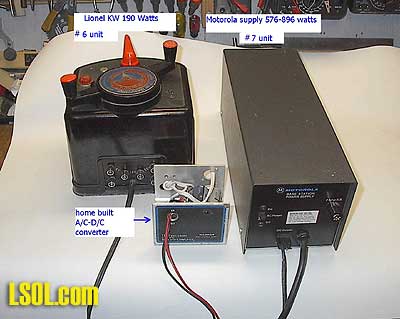 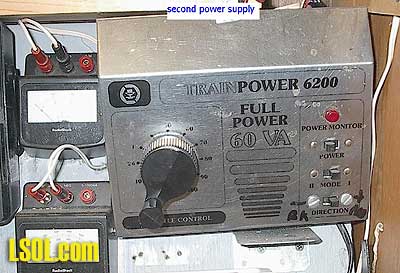 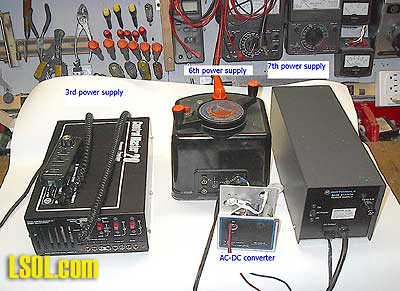  1st-- Lionel Trainmaster 1034 20 Volts @ 75 Watts AC transformer for my Lionel set 2nd-- LGB 21 Volts @ 7 Watts DC which came with the first large scale set 3rd-- MRC Train Power 6200 18.5 Volts @ 35 watts, used for bench testing now. 4th-- CMI Blue Hogger #101 20 Volts @ 90 Watts 5th-- CMI Super Blue Hogger 20 Volts @ 90 Watts, still in use today. 6th--Lionel KW 20 Volts @ 190 Watts with 50 Amp AC/DC Converter 7th--Motorola FM radio power supply 16 Volts @ 576 to 896 Watts 8th & in use today 28 Volts @ 400 Watts switching power supply. If you look to the web for electronic supplies you will find a vast number of companies that sell power supplies at a low cost. All you need is the will to tackle the project, and it is not that difficult. I built this system because for me it works very well and it is what I wanted, it might not be for everyone but it is another idea some might find attractive. Check out my article on converting a computer supply for my Christmas RR. Happy Railroading, John B Pedersen
| Power Supplies |
| Hi John, Do you recall the source for the 400w supply you are now using? I too have been looking for just such a unit. Also can you provide a diagram of the Relay "over-voltage circut you mention? I am using the Aristo TE and the MTH DCS system with a BridgeWerks 15 amp unit, but I need to provide additional power. PS the trouble with the BWerk's supply is the output voltage can exceed 30vcd !!! Thanks for the Article and any help you can give me. Dean Cull La Buena Vida RR |
| Dean Cull - 02/20/2008 - 11:10 |
Top of Page
|



